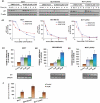JKA97, a novel benzylidene analog of harmine, exerts anti-cancer effects by inducing G1 arrest, apoptosis, and p53-independent up-regulation of p21
- PMID: 22558087
- PMCID: PMC3338851
- DOI: 10.1371/journal.pone.0034303
JKA97, a novel benzylidene analog of harmine, exerts anti-cancer effects by inducing G1 arrest, apoptosis, and p53-independent up-regulation of p21
Abstract
JKA97, a benzylidene analog of harmine, has been found to be a promising drug candidate for human cancer therapy, although the underlying molecular mechanisms have not been fully demonstrated. In this study, we evaluated the effects of JKA97 on human breast cancer cells in vitro and in vivo. JKA97 inhibited the growth and proliferation of MCF7 (p53 wild-type), MCF7 (p53 knockdown), and MDA-MB-468 (p53 mutant) cells in a dose-dependent manner. Treatment with JKA97 arrested breast cancer cells in G1 phase and induced apoptosis. JKA97 also significantly suppressed the growth of MCF7 and MDA-MB-468 xenograft tumors. It regulated the expression levels of G1 phase regulators, such as p21, p27, cyclinE, and cylinD1. JKA97 activated p21 transcription, independent of p53, but had little effect on p21 protein stability/degradation. In summary, our results suggest that JKA97 inhibits human breast cancer cell growth through activating p21, independent of p53, which provides a basis for developing this compound as a novel drug for human breast cancer therapy.
Conflict of interest statement
Figures




Similar articles
-
Anti-cancer effects of JKA97 are associated with its induction of cell apoptosis via a Bax-dependent and p53-independent pathway.J Biol Chem. 2008 Mar 28;283(13):8624-33. doi: 10.1074/jbc.M707860200. Epub 2008 Jan 23. J Biol Chem. 2008. PMID: 18218619 Free PMC article.
-
Penta-O-galloyl-beta-D-glucose induces G1 arrest and DNA replicative S-phase arrest independently of cyclin-dependent kinase inhibitor 1A, cyclin-dependent kinase inhibitor 1B and P53 in human breast cancer cells and is orally active against triple negative xenograft growth.Breast Cancer Res. 2010;12(5):R67. doi: 10.1186/bcr2634. Epub 2010 Sep 1. Breast Cancer Res. 2010. PMID: 20809980 Free PMC article.
-
8-Chloro-Adenosine Inhibits Proliferation of MDA-MB-231 and SK-BR-3 Breast Cancer Cells by Regulating ADAR1/p53 Signaling Pathway.Cell Transplant. 2020 Jan-Dec;29:963689720958656. doi: 10.1177/0963689720958656. Cell Transplant. 2020. PMID: 32907379 Free PMC article.
-
Caffeic acid phenethyl ester induced cell cycle arrest and growth inhibition in androgen-independent prostate cancer cells via regulation of Skp2, p53, p21Cip1 and p27Kip1.Oncotarget. 2015 Mar 30;6(9):6684-707. doi: 10.18632/oncotarget.3246. Oncotarget. 2015. PMID: 25788262 Free PMC article.
-
The investigational Aurora kinase A inhibitor alisertib (MLN8237) induces cell cycle G2/M arrest, apoptosis, and autophagy via p38 MAPK and Akt/mTOR signaling pathways in human breast cancer cells.Drug Des Devel Ther. 2015 Mar 16;9:1627-52. doi: 10.2147/DDDT.S75378. eCollection 2015. Drug Des Devel Ther. 2015. PMID: 25834401 Free PMC article.
Cited by
-
Identification of lineariifolianoid A as a novel dual NFAT1 and MDM2 inhibitor for human cancer therapy.J Biomed Res. 2016 Jul;30(4):322-33. doi: 10.7555/JBR.30.20160018. Epub 2016 May 25. J Biomed Res. 2016. PMID: 27533941 Free PMC article.
-
Targeting the NFAT1-MDM2-MDMX Network Inhibits the Proliferation and Invasion of Prostate Cancer Cells, Independent of p53 and Androgen.Front Pharmacol. 2017 Dec 14;8:917. doi: 10.3389/fphar.2017.00917. eCollection 2017. Front Pharmacol. 2017. PMID: 29311926 Free PMC article.
-
Toxic effects of mildly elevated homocysteine concentrations in neuronal-like cells.Neurochem Res. 2014 Aug;39(8):1485-95. doi: 10.1007/s11064-014-1338-7. Epub 2014 May 28. Neurochem Res. 2014. PMID: 24867323
-
A 3D culture platform enables development of zinc-binding prodrugs for targeted proliferation of β cells.Sci Adv. 2020 Nov 18;6(47):eabc3207. doi: 10.1126/sciadv.abc3207. Print 2020 Nov. Sci Adv. 2020. PMID: 33208361 Free PMC article.
-
Physcion, a naturally occurring anthraquinone derivative, induces apoptosis and autophagy in human nasopharyngeal carcinoma.Acta Pharmacol Sin. 2016 Dec;37(12):1623-1640. doi: 10.1038/aps.2016.98. Epub 2016 Oct 3. Acta Pharmacol Sin. 2016. Retraction in: Acta Pharmacol Sin. 2025 May;46(5):1493. doi: 10.1038/s41401-024-01433-2. PMID: 27694907 Free PMC article. Retracted.
References
-
- Jemal A, Bray F, Center MM, Ferlay J, Ward E, et al. Global cancer statistics. CA Cancer J Clin. 2011;61:69–90. - PubMed
-
- Nathanson KL, Domchek SM. Therapeutic approaches for women predisposed to breast cancer. Annu Rev Med. 2011;62:295–306. - PubMed
-
- Oakman C, Santarpia L, Di Leo A. Breast cancer assessment tools and optimizing adjuvant therapy. Nat Rev Clin Oncol. 2010;7:725–732. - PubMed
-
- Eskelinen M, Hippelainen M, Kettunen J, Salmela E, Penttila I, et al. Clinical value of serum tumour markers TPA, TPS, TAG 12, CA 15-3 and MCA in breast cancer diagnosis; results from a prospective study. Anticancer Res. 1994;14:699–703. - PubMed
-
- Koehn FE, Carter GT. The evolving role of natural products in drug discovery. Nat Rev Drug Discov. 2005;4:206–220. - PubMed
Publication types
MeSH terms
Substances
Grants and funding
LinkOut - more resources
Full Text Sources
Medical
Research Materials
Miscellaneous

